Lithofacies and Depositional Models of the Fine-Grained Sedimentary Rocks of the Albian–Turonian Stage in the Rio Muni Basin, West Africa
Abstract
:1. Introduction
2. Geological Setting
- (1)
- Rifting period (or interior fracture phase—Neocomian to early Aptian)
- (2)
- Rift–drift transitional period (or sag phase—middle to late Aptian)
- (3)
- Drifting period (or thermal sag phase—Albian to present)
3. Materials and Methods
3.1. Well and Sampling
3.2. TOC, XRD, and Thin Sections
3.3. SEM, EDS, Surface Scanning and EBSD
4. Results
4.1. Mineral Composition
4.2. Lithofacies
- (1)
- Siliceous-clayey fine-grained rock
- (2)
- Terrigenous clastic mixed fine-grained rock
- (3)
- Lime-mixed fine-grained rock
4.3. Framboidal Pyrite
5. Discussion
5.1. Depositional Model of Albian Source Rocks
5.1.1. Terrestrial Material Supply
5.1.2. Palaeoproductivity
5.1.3. Depositional Environment
5.1.4. Depositional Model of the Albian Stage
5.2. Depositional Model of Cenomanian–Turonian Source Rocks
5.2.1. Terrestrial Material Supply
5.2.2. Palaeoproductivity
5.2.3. Depositional Environment
5.2.4. Depositional Model of the Cenomanian–Turonian Stage
6. Conclusions
Author Contributions
Funding
Data Availability Statement
Acknowledgments
Conflicts of Interest
References
- Brownfield, M.E.; Charpentier, R.R. Geology and Total Petroleum Systems of the West-Central Coastal Province (7203), West Africa; Bulletin; U.S. Geological Survey: Washington, DC, USA, 2006; Volume 2207-B, p. 59. [Google Scholar]
- Zhao, J.; Cao, J.; Zhong, N.-N. Characteristics, Origin and Hydrocarbon Potential of the Upper Cretaceous Source Rock in the Rio Muni Basin, Equatorial Guinea. In Proceedings of the IOP Conference Series: Materials Science and Engineering; IOP Publishing: Bristol, UK, 2019; Volume 592, p. 012172. [Google Scholar]
- Lu, B.; Wang, W.; Du, X.; Huang, X.; Guo, Y.; Ji, X.; Feng, X. Review of Tectonic-Sedimentary Features of the Central-South Section of West African Continental Margin Basins. Adv. Mar. Sci. 2015, 33, 414–428. [Google Scholar] [CrossRef]
- Fu, Z.; Jiang, X.; Xiao, Y.; Wang, G.; Li, C.; Zhang, W. Tectonic Evolution and Petroleum Exploration Prospect in Rio Muni Basin, Equatorial Guinea. Mar. Geol. Front. 2014, 30, 41–47. [Google Scholar] [CrossRef]
- Beglinger, S.E.; Doust, H.; Cloetingh, S. Relating Petroleum System and Play Development to Basin Evolution: West African South Atlantic Basins. Mar. Pet. Geol. 2012, 30, 1–25. [Google Scholar] [CrossRef]
- Deng, R.; Deng, Y.; Yu, S.; Hou, D. Hydrocarbon Exploration Achievements and Exploration Potential of Coastal Basins in West Africa. Offshore Oil 2008, 28, 11–19. [Google Scholar] [CrossRef]
- Dailly, P.; Lowry, P.; Goh, K.; Monson, G. Exploration and Development of Ceiba Field, Rio Muni Basin, Southern Equatorial Guinea. Lead. Edge 2002, 21, 1140–1146. [Google Scholar] [CrossRef]
- Turner, J.P. Gravity-Driven Structures and Rift Basin Evolution: Rio Muni Basin, Offshore Equatorial West Africa. AAPG Bull. 1995, 79, 1138–1158. [Google Scholar] [CrossRef]
- Aplin, A.C.; Macquaker, J.H.S. Mudstone Diversity: Origin and Implications for Source, Seal, and Reservoir Properties in Petroleum Systems. AAPG Bull. 2011, 95, 2031–2059. [Google Scholar] [CrossRef]
- Krumbein, W.C. Shales and Their Environmental Significance. J. Sediment. Res. 1947, 17, 101–108. [Google Scholar] [CrossRef]
- Krumbein, W.C. The Dispersion of Fine-Grained Sediments for Mechanical Analysis. J. Sediment. Res. 1933, 3, 121–135. [Google Scholar] [CrossRef]
- Zou, C.; Yang, Z.; Zhang, G.; Hou, L.; Zhu, R.; Tao, S.; Yuan, X.; Dong, D.; Wang, Y.; Guo, Q.; et al. Conventional and Unconventional Petroleum “Orderly Accumulation”: Concept and Practical Significance. Pet. Explor. Dev. 2014, 41, 14–30. [Google Scholar] [CrossRef]
- Wilkin, R.T.; Barnes, H.L.; Brantley, S.L. The Size Distribution of Framboidal Pyrite in Modern Sediments: An Indicator of Redox Conditions. Geochim. Cosmochim. Acta 1996, 60, 3897–3912. [Google Scholar] [CrossRef]
- Han, C.; Jiang, Z.; Han, M.; Wu, M.; Lin, W. The Lithofacies and Reservoir Characteristics of the Upper Ordovician and Lower Silurian Black Shale in the Southern Sichuan Basin and Its Periphery, China. Mar. Pet. Geol. 2016, 75, 181–191. [Google Scholar] [CrossRef]
- Zhang, M.-M.; Liu, Z.-J.; Xu, S.-Z.; Hu, X.-F.; Sun, P.-C.; Wang, Y.-L. Analysis for the Paleosalinity and Lake-Level Changes of the Oil Shale Measures in the Lucaogou Formation in the Sangonghe Area of Southern Margin, Junggar Basin. Pet. Sci. Technol. 2014, 32, 1973–1980. [Google Scholar] [CrossRef]
- Loucks, R.G.; Ruppel, S.C. Mississippian Barnett Shale: Lithofacies and Depositional Setting of a Deep-Water Shale-Gas Succession in the Fort Worth Basin, Texas. AAPG Bull. 2007, 91, 579–601. [Google Scholar] [CrossRef]
- Wang, G.; Carr, T.R. Methodology of Organic-Rich Shale Lithofacies Identification and Prediction: A Case Study from Marcellus Shale in the Appalachian Basin. Comput. Geosci. 2012, 49, 151–163. [Google Scholar] [CrossRef]
- Liu, B.; Wang, H.; Fu, X.; Bai, Y.; Bai, L.; Jia, M.; He, B. Lithofacies and Depositional Setting of a Highly Prospective Lacustrine Shale Oil Succession from the Upper Cretaceous Qingshankou Formation in the Gulong Sag, Northern Songliao Basin, Northeast China. AAPG Bull. 2019, 103, 405–432. [Google Scholar] [CrossRef]
- Chen, S.; Zhang, S.; Wang, Y.; Tan, M. Lithofacies Types and Reservoirs of Paleogene Fine-Grained Sedimentary Rocks Dongying Sag, Bohai Bay Basin, China. Pet. Explor. Dev. 2016, 43, 218–229. [Google Scholar] [CrossRef]
- Du, X.-B.; Zhang, M.-Q.; Lu, Y.-C.; Ping, C.; Lu, Y.-B. Lithofacies and Depositional Characteristics of Gas Shales in the Western Area of the Lower Yangtze, China. Geol. J. 2015, 50, 683–701. [Google Scholar] [CrossRef]
- Jadoon, Q.K.; Roberts, E.M.; Henderson, B.; Blenkinsop, T.G.; Wüst, R.A.; Mtelela, C. Lithological and Facies Analysis of the Roseneath and Murteree Shales, Cooper Basin, Australia. J. Nat. Gas Sci. Eng. 2017, 37, 138–168. [Google Scholar] [CrossRef]
- Wang, G.; Carr, T.R. Organic-Rich Marcellus Shale Lithofacies Modeling and Distribution Pattern Analysis in the Appalachian Basin. AAPG Bull. 2013, 97, 2173–2205. [Google Scholar] [CrossRef]
- Zhang, M.; Li, Z. The Lithofacies and Reservoir Characteristics of the Fine-Grained Sedimentary Rocks of the Permian Lucaogou Formation at the Northern Foot of Bogda Mountains, Junggar Basin (NW China). J. Pet. Sci. Eng. 2018, 170, 21–39. [Google Scholar] [CrossRef]
- Liang, C.; Jiang, Z.; Cao, Y.; Wu, M.; Guo, L.; Zhang, C. Deep-Water Depositional Mechanisms and Significance for Unconventional Hydrocarbon Exploration: A Case Study from the Lower Silurian Longmaxi Shale in the Southeastern Sichuan Basin. AAPG Bull. 2016, 100, 773–794. [Google Scholar] [CrossRef]
- Liang, C.; Jiang, Z.; Yang, Y.; Wei, X. Shale Lithofacies and Reservoir Space of the Wufeng–Longmaxi Formation, Sichuan Basin, China. Pet. Explor. Dev. 2012, 39, 736–743. [Google Scholar] [CrossRef]
- Ozkan, A.; Cumella, S.P.; Milliken, K.L.; Laubach, S.E. Prediction of Lithofacies and Reservoir Quality Using Well Logs, Late Cretaceous Williams Fork Formation, Mamm Creek Field, Piceance Basin, Colorado. AAPG Bull. 2011, 95, 1699–1723. [Google Scholar] [CrossRef]
- Dailly, P.; Goh, K.; Lowry, P. The Rio Muni Basin of Equatorial Guinea: A New Hydrocarbon Province. In Petroleum Systems of Deep-Water Basins–Global and Gulf of Mexico Experience; Fillon, R.H., Rosen, N.C., Weimer, P., Lowrie, A., Pettingill, H., Phair, R.L., Roberts, H.H., van Hoom, H.H., Eds.; SEPM Society for Sedimentary Geology: Tulsa, OK, USA, 2001; Volume 21, pp. 241–251. ISBN 978-0-9836096-9-8. [Google Scholar]
- Lawrence, S.R.; Munday, S.; Bray, R. Regional Geology and Geophysics of the Eastern Gulf of Guinea (Niger Delta to Rio Muni). Lead. Edge 2002, 21, 1112–1117. [Google Scholar] [CrossRef]
- Meyers, J.B.; Rosendahl, B.R.; Groschel-Becker, H.; Austin, J.A.; Rona, P.A. Deep Penetrating MCS Imaging of the Rift-to-Drift Transition, Offshore Douala and North Gabon Basins, West Africa. Mar. Pet. Geol. 1996, 13, 791–835. [Google Scholar] [CrossRef]
- Turner, J.P.; Rosendahl, B.R.; Wilson, P.G. Structure and Evolution of an Obliquely Sheared Continental Margin: Rio Muni, West Africa. Tectonophysics 2003, 374, 41–55. [Google Scholar] [CrossRef]
- Wilson, P.G.; Turner, J.P.; Westbrook, G.K. Structural Architecture of the Ocean–Continent Boundary at an Oblique Transform Margin through Deep-Imaging Seismic Interpretation and Gravity Modelling: Equatorial Guinea, West Africa. Tectonophysics 2003, 374, 19–40. [Google Scholar] [CrossRef]
- Lv, F.; Xu, Z.; Fan, G.; Shao, D.; Mao, C. Petroleum Geology and Exploration Directions in Rio Muni Basin, Equatorial Guinea. Mar. Pet. Geol. 2011, 16, 45–50. [Google Scholar] [CrossRef]
- Basilone, L.; Roberts, G.G.; Almeida, N.M.; Fernandes, V.M.; Souza, A.C.B.; Alves, D.P.V.; Jovane, L. Cretaceous to Recent Tectono-Sedimentary History and Subsidence of the Barreirinhas, Ceará and Potiguar Basins, Brazilian Equatorial Margin. Basin Res. 2023, 7, 1–24. [Google Scholar] [CrossRef]
- Basile, C.; Mascle, J.; Guiraud, R. Phanerozoic Geological Evolution of the Equatorial Atlantic Domain. J. Afr. Earth Sci. 2005, 43, 275–282. [Google Scholar] [CrossRef]
- Lehner, P.; De Ruiter, P.A.C. Structural History of Atlantic Margin of Africa. AAPG Bull. 1977, 61, 961–981. [Google Scholar] [CrossRef]
- Olsen, P.E. Giant Lava Flows, Mass Extinctions, and Mantle Plumes. Science 1999, 284, 604–605. [Google Scholar] [CrossRef]
- Jackson, M.P.; Cramez, C.; Fonck, J.-M. Role of Subaerial Volcanic Rocks and Mantle Plumes in Creation of South Atlantic Margins: Implications for Salt Tectonics and Source Rocks. Mar. Pet. Geol. 2000, 17, 477–498. [Google Scholar] [CrossRef]
- Rasmussen, E.S. Structural Evolution and Sequence Formation Offshore South Gabon during the Tertiary. Tectonophysics 1996, 266, 509–523. [Google Scholar] [CrossRef]
- Aslanian, D.; Moulin, M.; Olivet, J.-L.; Unternehr, P.; Matias, L.; Bache, F.; Rabineau, M.; Nouzé, H.; Klingelheofer, F.; Contrucci, I.; et al. Brazilian and African Passive Margins of the Central Segment of the South Atlantic Ocean: Kinematic Constraints. Tectonophysics 2009, 468, 98–112. [Google Scholar] [CrossRef]
- Karner, G.D.; Driscoll, N.W.; Barker, D.H.N. Syn-Rift Regional Subsidence across the West African Continental Margin: The Role of Lower Plate Ductile Extension. Geol. Soc. Lond. Spec. Publ. 2003, 207, 105–129. [Google Scholar] [CrossRef]
- Dias-Brito, D. The Meso-Cretaceous of the Campos Basin–a Contribution to the Paleo-Oceanography of the Early South Atlantic. Rev. Bras. De Geocienc. 1987, 17, 162–167. [Google Scholar] [CrossRef]
- Liu, Q.; Hu, X.; Yu, S.; Yu, Y.; Zhang, Y.; Hao, L.; Peng, J. Petroleum Geology and Reservoir Formation Characteristics of Rio Muni Basin in West Africa. Offshore Oil 2012, 32, 23–28. [Google Scholar]
- Babonneau, N.; Savoye, B.; Cremer, M.; Bez, M. Multiple Terraces within the Deep Incised Zaire Valley (ZaïAngo Project): Are They Confined Levees? Geol. Soc. Lond. Spec. Publ. 2004, 222, 91–114. [Google Scholar] [CrossRef]
- Droz, L.; Marsset, T.; Ondreas, H.; Lopez, M.; Savoye, B.; Spy-Anderson, F.-L. Architecture of an Active Mud-Rich Turbidite System: The Zaire Fan (Congo–Angola Margin Southeast Atlantic) Results from ZaïAngo 1 and 2 Cruises. AAPG Bull. 2003, 87, 1145–1168. [Google Scholar] [CrossRef]
- Séranne, M.; Anka, Z. South Atlantic Continental Margins of Africa: A Comparison of the Tectonic vs Climate Interplay on the Evolution of Equatorial West Africa and SW Africa Margins. J. Afr. Earth Sci. 2005, 43, 283–300. [Google Scholar] [CrossRef]
- Dimberline, A.J.; Bell, A.; Woodcock, N.H. A Laminated Hemipelagic Facies from the Wenlock and Ludlow of the Welsh Basin. J. Geol. Soc. 1990, 147, 693–701. [Google Scholar] [CrossRef]
- Lemons, D.R.; Chan, M.A. Facies Architecture and Sequence Stratigraphy of Fine-Grained Lacustrine Deltas along the Eastern Margin of Late Pleistocene Lake Bonneville, Northern Utah and Southern Idaho. AAPG Bull. 1999, 83, 635–665. [Google Scholar] [CrossRef]
- Abouelresh, M.O.; Slatt, R.M. Lithofacies and Sequence Stratigraphy of the Barnett Shale in East-Central Fort Worth Basin, Texas. AAPG Bull. 2012, 96, 1–22. [Google Scholar] [CrossRef]
- Lazar, O.R.; Bohacs, K.M.; Macquaker, J.H.; Schieber, J.; Demko, T.M. Capturing Key Attributes of Fine-Grained Sedimentary Rocks In Outcrops, Cores, and Thin Sections: Nomenclature and Description GuidelinesMUDSTONES: NOMENCLATURE AND DESCRIPTION GUIDELINES. J. Sediment. Res. 2015, 85, 230–246. [Google Scholar] [CrossRef]
- Hickey, J.J.; Henk, B. Lithofacies Summary of the Mississippian Barnett Shale, Mitchell 2 TP Sims Well, Wise County, Texas. AAPG Bull. 2007, 91, 437–443. [Google Scholar] [CrossRef]
- Bond, D.P.; Wignall, P.B. Pyrite Framboid Study of Marine Permian–Triassic Boundary Sections: A Complex Anoxic Event and Its Relationship to Contemporaneous Mass Extinction. Geol. Soc. Am. Bull. 2010, 122, 1265–1279. [Google Scholar] [CrossRef]
- Wilkin, R.T.; Barnes, H.L. Formation Processes of Framboidal Pyrite. Geochim. Cosmochim. Acta 1997, 61, 323–339. [Google Scholar] [CrossRef]
- Zhou, C.; Jiang, S.-Y. Palaeoceanographic Redox Environments for the Lower Cambrian Hetang Formation in South China: Evidence from Pyrite Framboids, Redox Sensitive Trace Elements, and Sponge Biota Occurrence. Palaeogeogr. Palaeoclimatol. Palaeoecol. 2009, 271, 279–286. [Google Scholar] [CrossRef]
- Canfield, D.E.; Thamdrup, B. The Production of 34S-Depleted Sulfide during Bacterial Disproportionation of Elemental Sulfur. Science 1994, 266, 1973–1975. [Google Scholar] [CrossRef] [PubMed]
- Raiswell, R. Pyrite Texture, Isotopic Composition and the Availability of Iron. Am. J. Sci. 1982, 282, 1244–1263. [Google Scholar] [CrossRef]
- Ariztegui, D.; Farrimond, P.; McKenzie, J.A. Compositional Variations in Sedimentary Lacustrine Organic Matter and Their Implications for High Alpine Holocene Environmental Changes: Lake St. Moritz, Switzerland. Org. Geochem. 1996, 24, 453–461. [Google Scholar] [CrossRef]
- Jacobs, M.B.; Hays, J.D. Paleo-Climatic Events Indicated by Mineralogical Changes in Deep-Sea Sediments. J. Sediment. Res. 1972, 42, 889–898. [Google Scholar] [CrossRef]
- Singer, A. The Paleoclimatic Interpretation of Clay Minerals in Sediments—A Review. Earth Sci. Rev. 1984, 21, 251–293. [Google Scholar] [CrossRef]
- Basilone, L.; Perri, F.; Sulli, A.; Critelli, S. Paleoclimate and Extensional Tectonics of Short-Lived Lacustrine Environments. Lower Cretaceous of the Panormide Southern Tethyan Carbonate Platform (NW Sicily). Mar. Pet. Geol. 2017, 88, 428–439. [Google Scholar] [CrossRef]
- Basilone, L. Synsedimentary Tectonics vs Paleoclimatic Changes across the Aptian-Albian Boundary along the Southern Tethyan Margin: The Panormide Carbonate Platform Case History (NW Sicily). Mar. Pet. Geol. 2021, 124, 104801. [Google Scholar] [CrossRef]
- Nieto, L.M.; Molina, J.M.; Ruiz-Ortiz, P.A.; Castro, J.M.; Reolid, M.; Gea, G.A. Palustrine Sediments between Two Isolated Shallow Carbonate Platforms (Aptian–Albian Transition, Prebetic of Jaén, South Spain). Minerals 2022, 12, 116. [Google Scholar] [CrossRef]
- McAnena, A.; Flögel, S.; Hofmann, P.; Herrle, J.O.; Griesand, A.; Pross, J.; Talbot, H.M.; Rethemeyer, J.; Wallmann, K.; Wagner, T. Atlantic Cooling Associated with a Marine Biotic Crisis during the Mid-Cretaceous Period. Nat. Geosci. 2013, 6, 558–561. [Google Scholar] [CrossRef]
- Peybernes, C.; Giraud, F.; Jaillard, E.; Robert, E.; Masrour, M.; Aoutem, M.; Içame, N. Stratigraphic Framework and Calcareous Nannofossil Productivity of the Essaouira-Agadir Basin (Morocco) during the Aptian–Early Albian: Comparison with the North-Tethyan Margin. Cretac. Res. 2013, 39, 149–169. [Google Scholar] [CrossRef]
- Föllmi, K.B. Early Cretaceous Life, Climate and Anoxia. Cretac. Res. 2012, 35, 230–257. [Google Scholar] [CrossRef]
- Murray, R.W.; Leinen, M. Scavenged Excess Aluminum and Its Relationship to Bulk Titanium in Biogenic Sediment from the Central Equatorial Pacific Ocean. Geochim. Cosmochim. Acta 1996, 60, 3869–3878. [Google Scholar] [CrossRef]
- Wei, G.; Liu, Y.; Li, X.; Liang, X.; Shao, L. Excess Al in the Sediments from the South China Sea. Bull. Mineral. Petrol. Geochem. 2003, 22, 23–25. [Google Scholar]
- Algeo, T.J.; Kuwahara, K.; Sano, H.; Bates, S.; Lyons, T.; Elswick, E.; Hinnov, L.; Ellwood, B.; Moser, J.; Maynard, J.B. Spatial Variation in Sediment Fluxes, Redox Conditions, and Productivity in the Permian–Triassic Panthalassic Ocean. Palaeogeogr. Palaeoclimatol. Palaeoecol. 2011, 308, 65–83. [Google Scholar] [CrossRef]
- Latimer, J.C.; Filippelli, G.M. Eocene to Miocene Terrigenous Inputs and Export Production: Geochemical Evidence from ODP Leg 177, Site 1090. Palaeogeogr. Palaeoclimatol. Palaeoecol. 2002, 182, 151–164. [Google Scholar] [CrossRef]
- Jenkyns, H.C. Geochemistry of Oceanic Anoxic Events. Geochem. Geophys. Geosyst. 2010, 11, 3. [Google Scholar] [CrossRef]
- Föllmi, K.B.; Weissert, H.; Bisping, M.; Funk, H. Phosphogenesis, Carbon-Isotope Stratigraphy, and Carbonate-Platform Evolution along the Lower Cretaceous Northern Tethyan Margin. GSA Bull. 1994, 106, 729–746. [Google Scholar] [CrossRef]
- Bottini, C.; Erba, E. Mid-Cretaceous Paleoenvironmental Changes in the Western Tethys. Clim. Past 2018, 14, 1147–1163. [Google Scholar] [CrossRef]
- Mutterlose, J.; Bottini, C. Early Cretaceous Chalks from the North Sea Giving Evidence for Global Change. Nat. Commun. 2013, 4, 1686. [Google Scholar] [CrossRef]
- Mutterlose, J.; Bottini, C.; Schouten, S.; Damsté, J.S.S. High Sea-Surface Temperatures during the Early Aptian Oceanic Anoxic Event 1a in the Boreal Realm. Geology 2014, 42, 439–442. [Google Scholar] [CrossRef]
- Erba, E.; Bottini, C.; Weissert, H.J.; Keller, C.E. Calcareous Nannoplankton Response to Surface-Water Acidification Around Oceanic Anoxic Event 1a. Science 2010, 329, 428–432. [Google Scholar] [CrossRef]
- Chen, S.; Zhang, S.; Liu, H.; Yan, J. Discussion on Mixing of Fine-Grained Sediments in Lacustrine Deep Water. J. Palaeogeogr. 2017, 19, 271–284. [Google Scholar]
- Jiang, Z.; Zhang, W.; Liang, C.; Wang, Y.; Liu, H.; Chen, X. Characteristics and Evaluation Elements of Shale Oil Reservoir. Acta Pet. Sin. 2014, 35, 184–196. [Google Scholar] [CrossRef]
- Zhu, E.; Yu, L.; Li, J.; Xia, M. Color of surficial sediments in the northern part of the east China sea. Mar. Geol. Quat. Geol. 1983, 1, 67–73. [Google Scholar] [CrossRef]
- Jones, B.; Manning, D.A. Comparison of Geochemical Indices Used for the Interpretation of Palaeoredox Conditions in Ancient Mudstones. Chem. Geol. 1994, 111, 111–129. [Google Scholar] [CrossRef]
- Scheffler, K.; Buehmann, D.; Schwark, L. Analysis of Late Palaeozoic Glacial to Postglacial Sedimentary Successions in South Africa by Geochemical Proxies–Response to Climate Evolution and Sedimentary Environment. Palaeogeogr. Palaeoclimatol. Palaeoecol. 2006, 240, 184–203. [Google Scholar] [CrossRef]
- Kimura, H.; Watanabe, Y. Oceanic Anoxia at the Precambrian-Cambrian Boundary. Geology 2001, 29, 995–998. [Google Scholar] [CrossRef]
- Wignall, P.B.; Myers, K.J. Interpreting Benthic Oxygen Levels in Mudrocks: A New Approach. Geology 1988, 16, 452–455. [Google Scholar] [CrossRef]
- Wignall, P.B.; Twitchett, R.J. Oceanic Anoxia and the End Permian Mass Extinction. Science 1996, 272, 1155–1158. [Google Scholar] [CrossRef]
- Wang, Z.; Zhang, Y.; Liang, X.; Cheng, X.; Jin, Q.; Liu, W.; Zhang, H.; Li, H. Characteristics of shale lithofacies formed under different hydrodynamic conditions in the Wufeng-Longmaxi Formation, Sichuan Basin. Acta Pet. Sin. 2014, 35, 623–632. [Google Scholar] [CrossRef]
- Liang, C.; Jiang, Z.; Yang, Y.; Wei, X. Characteristics of shale lithofacies and reservoir space of the Wufeng–Longmaxi Formation, Sichuan Basin. Pet. Explor. Dev. 2012, 39, 691–698. [Google Scholar]
- Zhao, J.; Jin, Z.; Jin, Z.; Wen, X.; Geng, Y.; Yan, C.; Niu, H. Lithofacies types and sedimentary environment of shale in Wufeng-Longmaxi Formation, Sichuan Basin. Acta Pet. Sin. 2016, 37, 572–586. [Google Scholar]
- Rhoads, D.C.; Morse, J.W. Evolutionary and Ecologic Significance of Oxygen-Deficient Marine Basins. Lethaia 1971, 4, 413–428. [Google Scholar] [CrossRef]
- Haq, B.U. Cretaceous Eustasy Revisited. Glob. Planet. Change 2014, 113, 44–58. [Google Scholar] [CrossRef]
- Biscaye, P.E. Mineralogy and Sedimentation of Recent Deep-Sea Clay in the Atlantic Ocean and Adjacent Seas and Oceans. GSA Bull. 1965, 76, 803–832. [Google Scholar] [CrossRef]
- Rateev, M.A.; Gorbunova, Z.N.; Lisitzyn, A.P.; Nosov, G.L. The Distribution of Clay Minerals in the Oceans. Sedimentology 1969, 13, 21–43. [Google Scholar] [CrossRef]
- Merriman, R.J. Clay Minerals and Sedimentary Basin History. Eur. J. Mineral. 2005, 17, 7–20. [Google Scholar] [CrossRef]
- Nesbitt, H.W.; Young, G.M. Formation and Diagenesis of Weathering Profiles. J. Geol. 1989, 97, 129–147. [Google Scholar] [CrossRef]
- Borrelli, L.; Perri, F.; Critelli, S.; Gullà, G. Characterization of Granitoid and Gneissic Weathering Profiles of the Mucone River Basin (Calabria, Southern Italy). CATENA 2014, 113, 325–340. [Google Scholar] [CrossRef]
- Borrelli, L.; Perri, F.; Critelli, S.; Gullà, G. Minero-Petrographical Features of Weathering Profiles in Calabria, Southern Italy. CATENA 2012, 92, 196–207. [Google Scholar] [CrossRef]
- Perri, F.; Dominici, R.; Le Pera, E.; Chiocci, F.L.; Martorelli, E. Holocene Sediments of the Messina Strait (Southern Italy): Relationships between Source Area and Depositional Basin. Mar. Pet. Geol. 2016, 77, 553–566. [Google Scholar] [CrossRef]
- Goldberg, E.D.; Arrhenius, G.O.S. Chemistry of Pacific Pelagic Sediments. Geochim. Cosmochim. Acta 1958, 13, 153–212. [Google Scholar] [CrossRef]
- Farrimond, P.; Eglinton, G.; Brassell, S.C.; Jenkyns, H.C. The Cenomanian/Turonian Anoxic Event in Europe: An Organic Geochemical Study. Mar. Pet. Geol. 1990, 7, 75–89. [Google Scholar] [CrossRef]
- Jati, M.; Grosheny, D.; Ferry, S.; Masrour, M.; Aoutem, M.; Içame, N.; Gauthier-Lafaye, F.; Desmares, D. The Cenomanian–Turonian Boundary Event on the Moroccan Atlantic Margin (Agadir Basin): Stable Isotope and Sequence Stratigraphy. Palaeogeogr. Palaeoclimatol. Palaeoecol. 2010, 296, 151–164. [Google Scholar] [CrossRef]
- Dai, N.; Zhong, N.; Deng, Y.; Li, W.; Kang, H. Genetic types of marine source rock in Meso-Cenozoic continental margin basins. Acta Pet. Sin. 2015, 36, 940–953. [Google Scholar] [CrossRef]
- Deng, Y. River-gulf system—The major location of marine source rock formation. Pet. Sci. 2012, 9, 281–289. [Google Scholar] [CrossRef]
- Doust, H.; Noble, R.A. Petroleum Systems of Indonesia. Mar. Pet. Geol. 2008, 25, 103–129. [Google Scholar] [CrossRef]
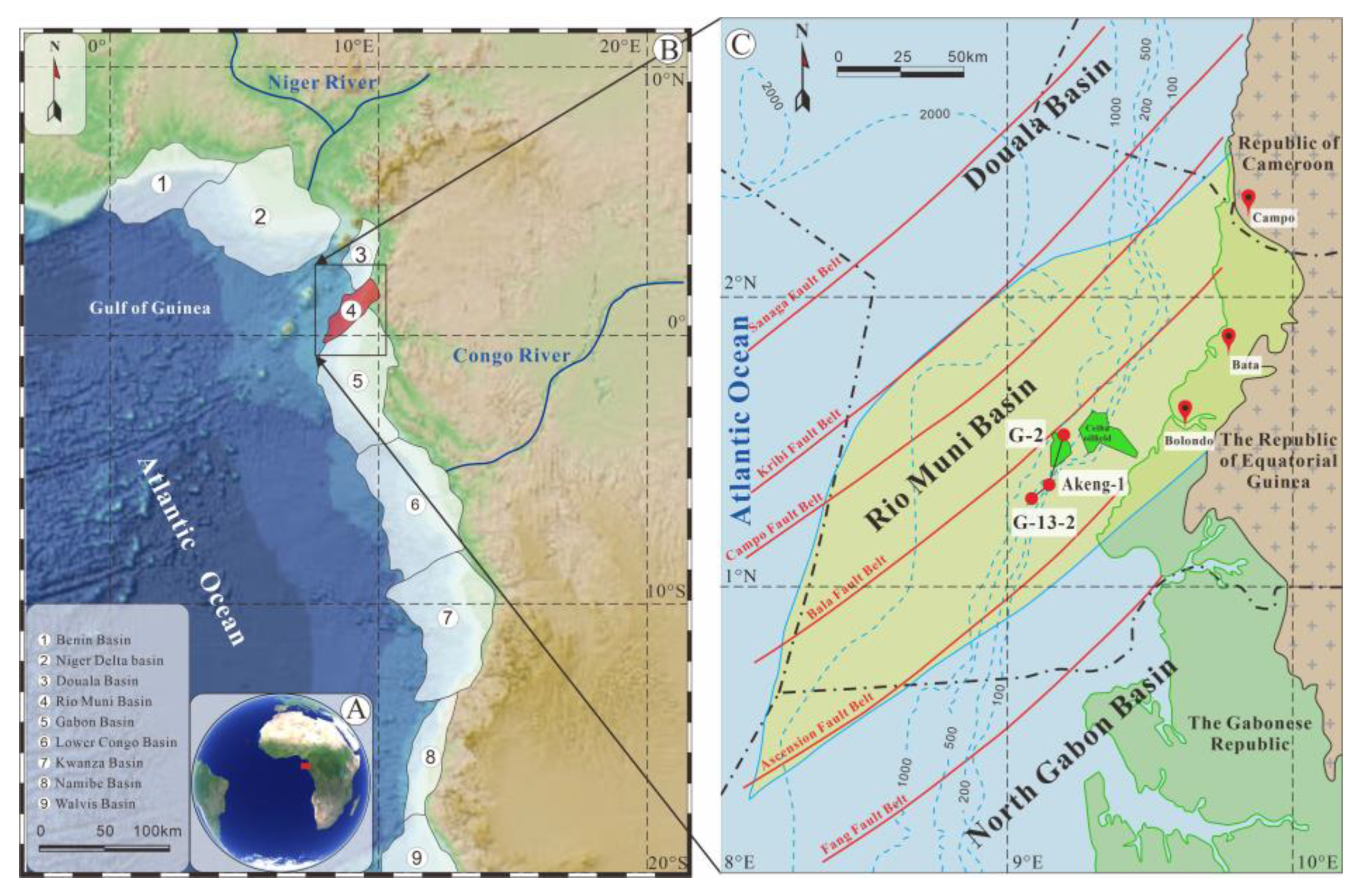

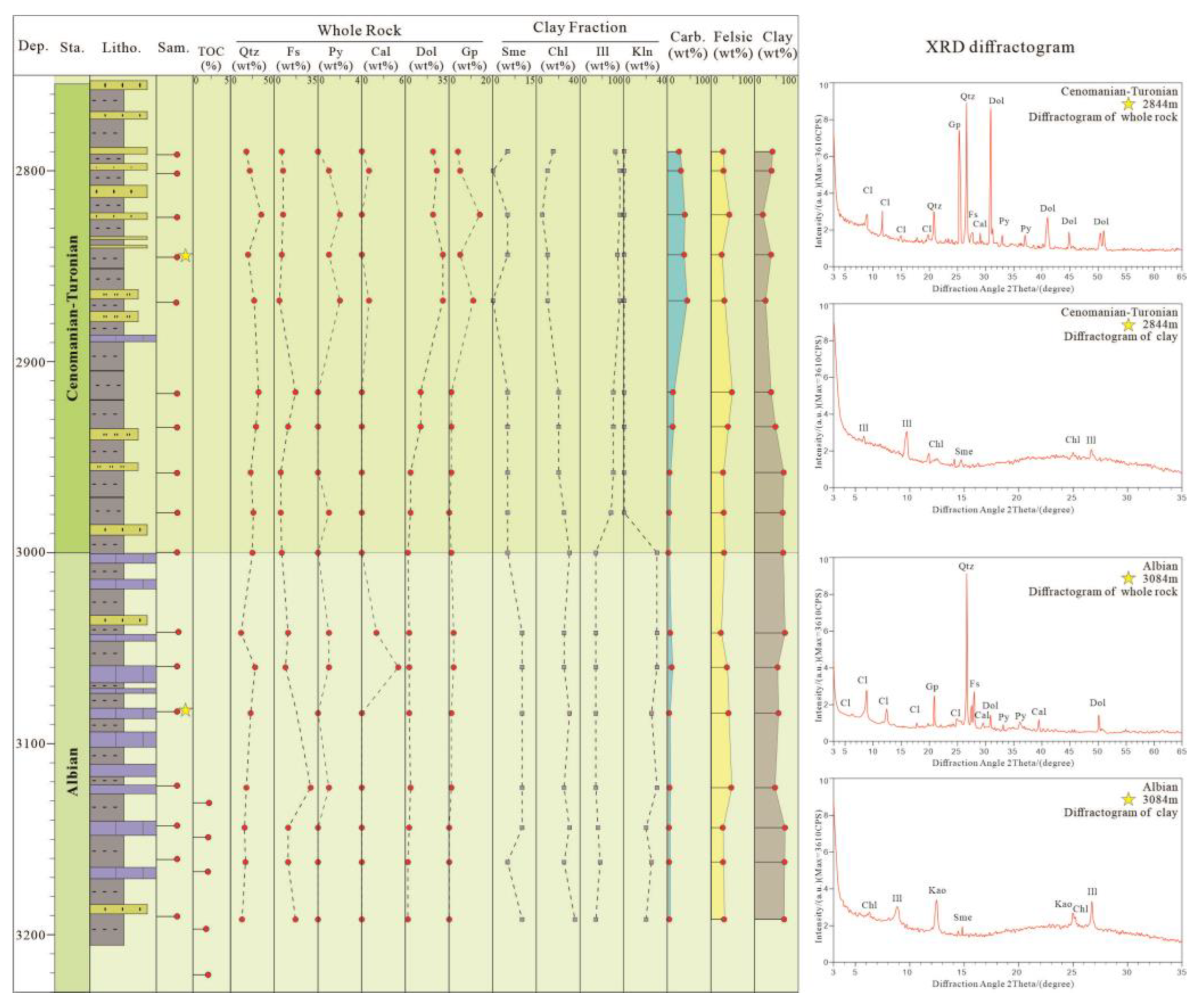
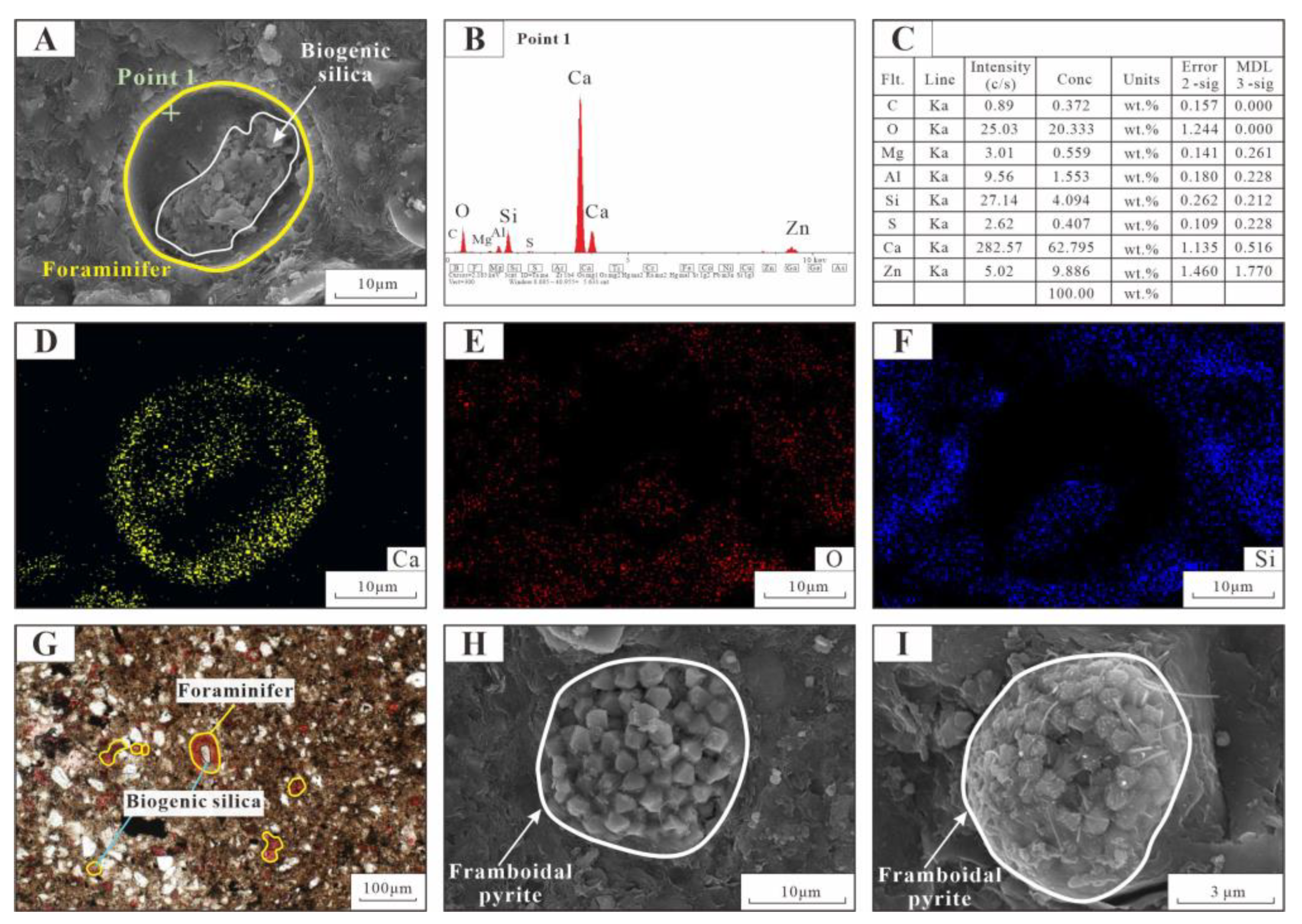
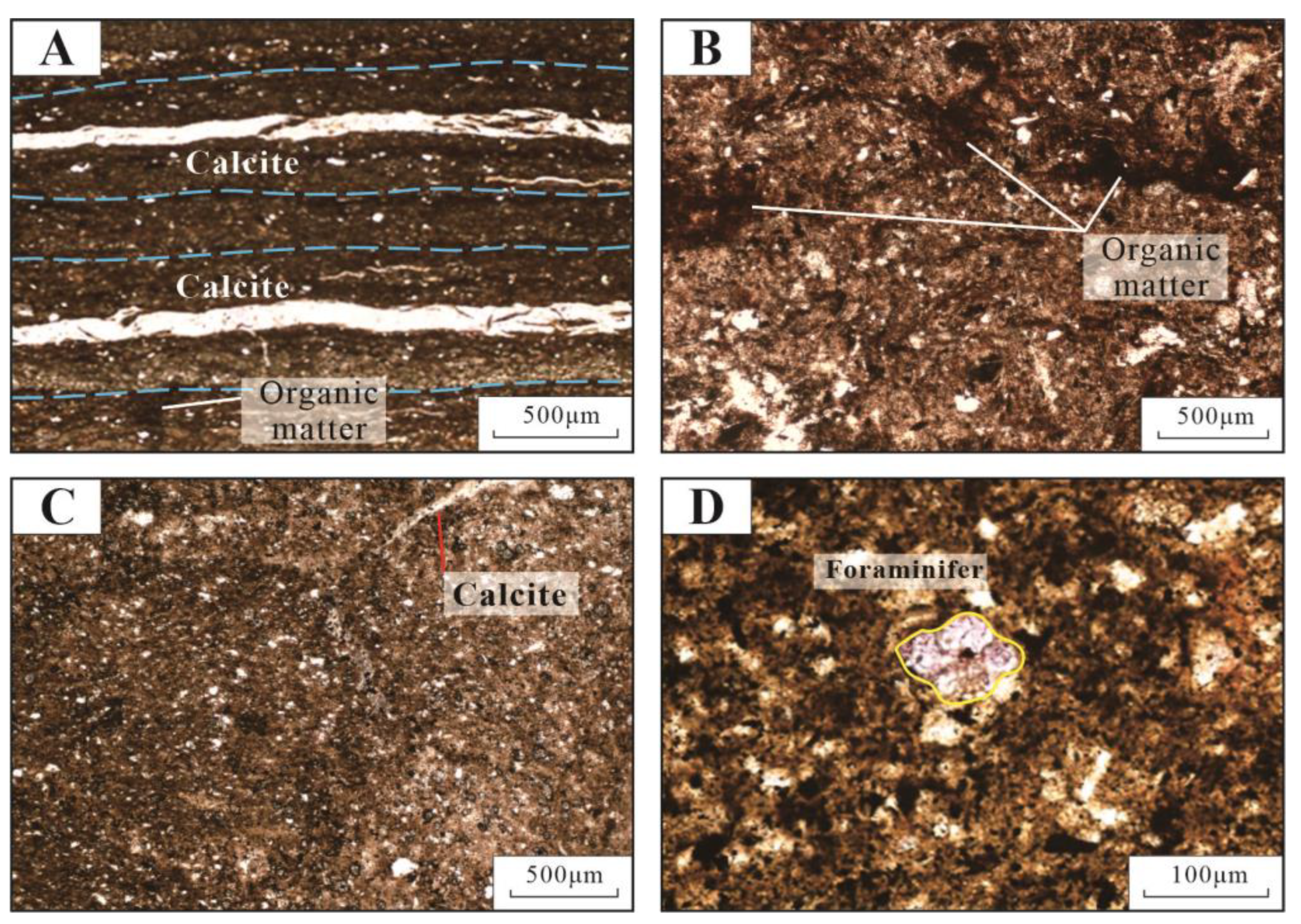
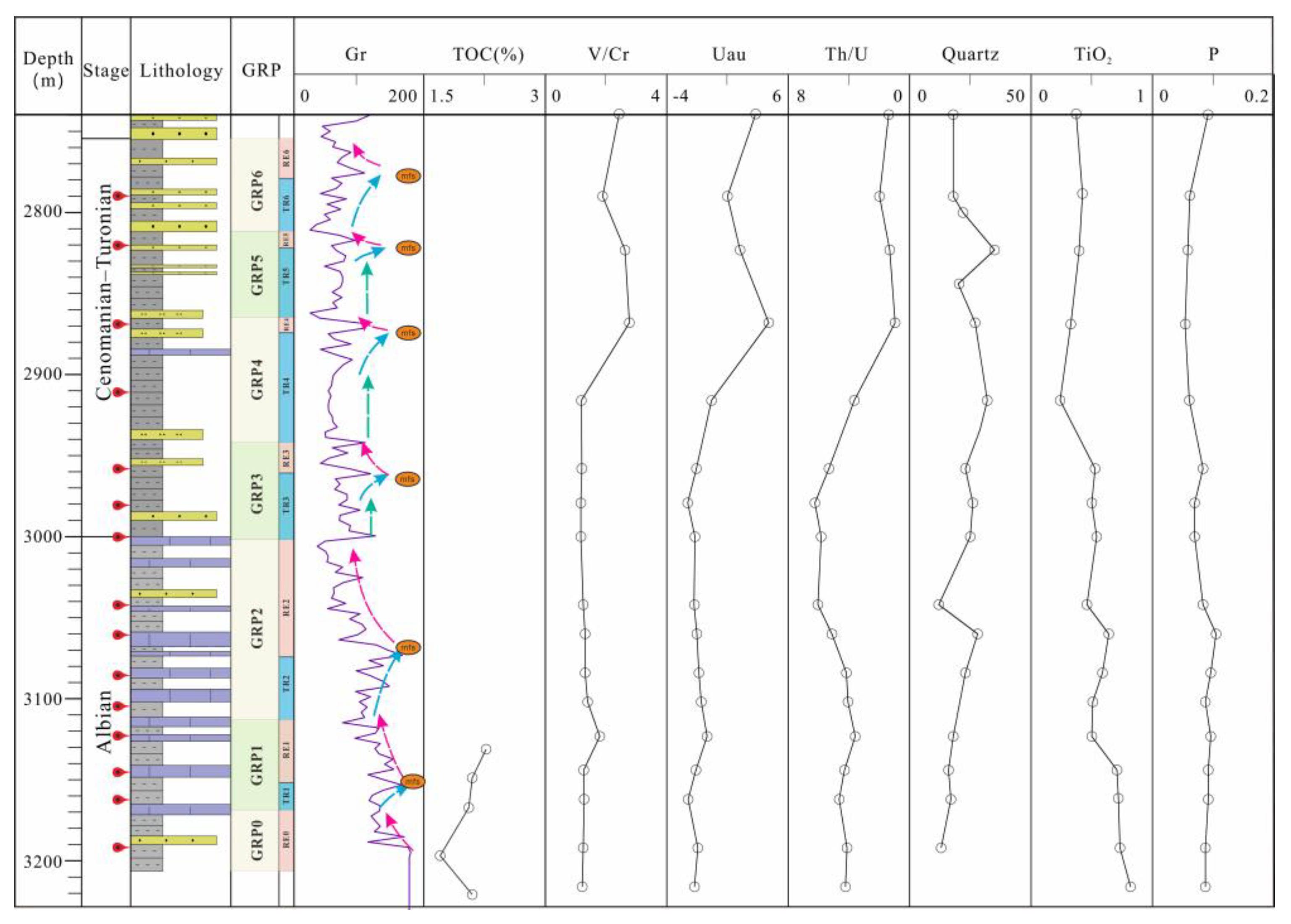


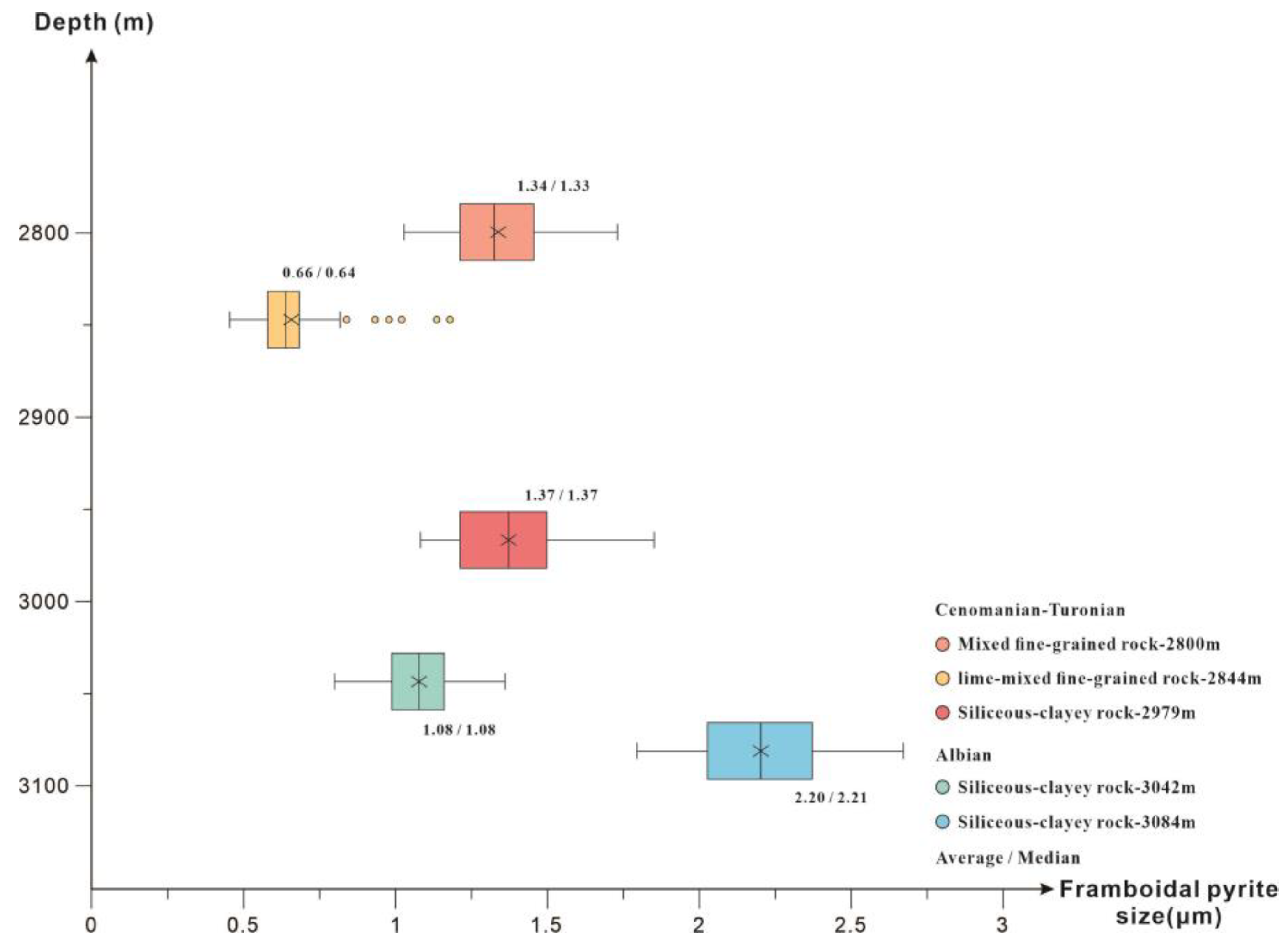
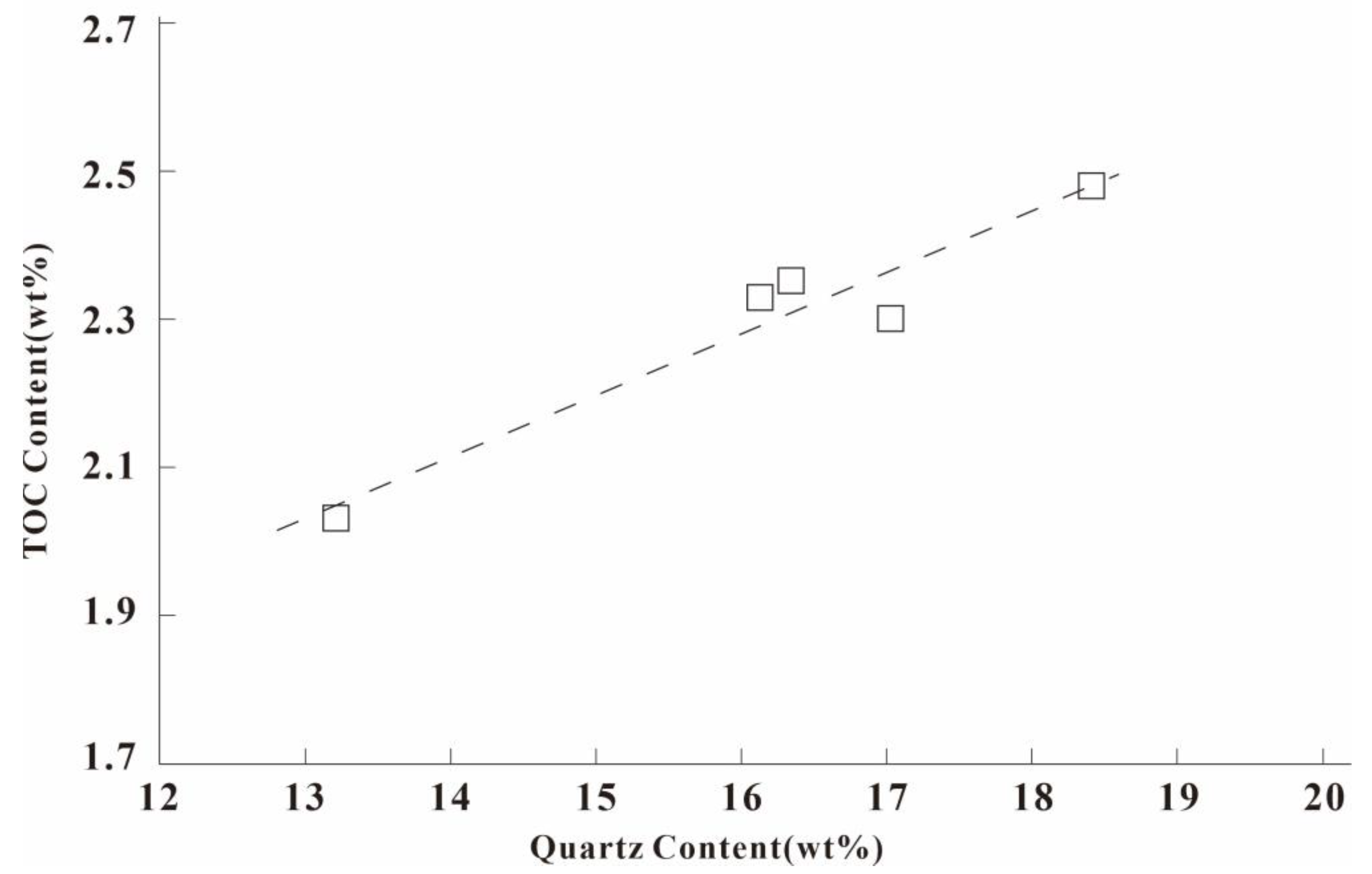

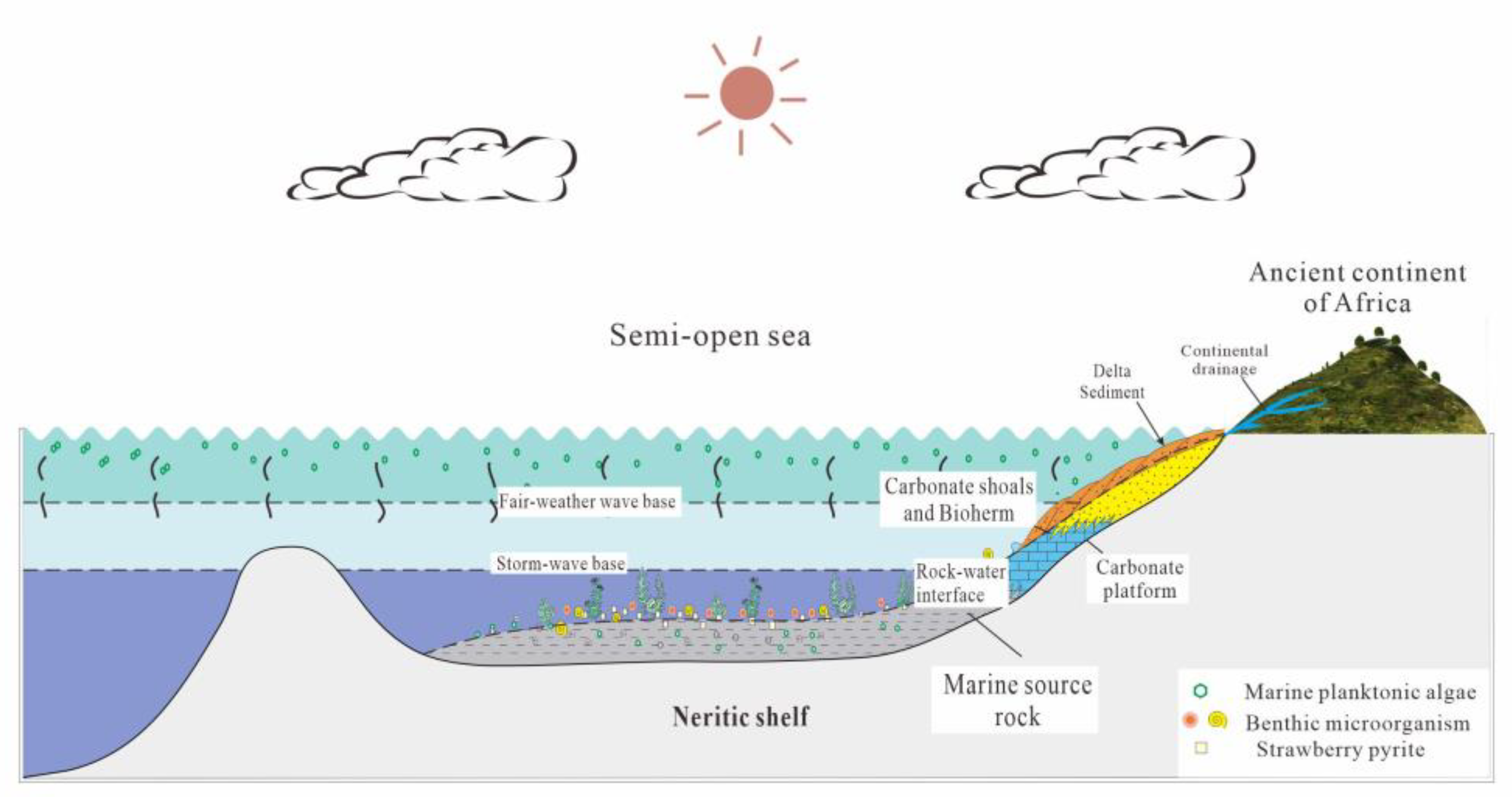
| Stage | Depth (m) | Whole-Rock Minerals, wt% | Clay Minerals, wt% | Lithofacies Types | |||||||||
|---|---|---|---|---|---|---|---|---|---|---|---|---|---|
| Qtz (wt%) | Fs (wt%) | Py (wt%) | Cal (wt%) | Dol (wt%) | Gp (wt%) | Clay (wt%) | Sme (wt%) | Chl (wt%) | Ill (wt%) | Kln (wt%) | |||
| Cenomanian–Turonian | 2790 | 20.83 | 6.94 | 0.32 | 3.00 | 22.93 | 4.91 | 41.10 | 5.00 | 15.00 | 80.00 | 0.00 | Terrigenous clastic mixed fine-grained rock |
| 2800 | 21.73 | 7.38 | 1.44 | 0.55 | 25.19 | 5.03 | 39.00 | 0.00 | 10.00 | 90.00 | 0.00 | Terrigenous clastic mixed fine-grained rock | |
| 2823 | 35.06 | 7.49 | 2.07 | 0.00 | 22.46 | 13.77 | 19.00 | 5.00 | 5.00 | 90.00 | 0.00 | Lime-mixed fine-grained rock | |
| 2844 | 19.54 | 5.58 | 1.37 | 0.47 | 29.64 | 5.27 | 38.00 | 5.00 | 10.00 | 85.00 | 0.00 | Lime-mixed fine-grained rock | |
| 2868 | 26.81 | 3.96 | 1.88 | 1.11 | 30.41 | 10.62 | 25.00 | 0.00 | 10.00 | 90.00 | 0.00 | Lime-mixed fine-grained rock | |
| 2916 | 31.69 | 17.00 | 0.45 | 0.42 | 11.76 | 1.00 | 38.00 | 5.00 | 20.00 | 75.00 | 0.00 | Terrigenous clastic mixed fine-grained rock | |
| 2934 | 28.70 | 10.86 | 0.00 | 0.00 | 11.78 | 1.04 | 48.00 | 5.00 | 20.00 | 75.00 | 0.00 | Terrigenous clastic mixed fine-grained rock | |
| 2958 | 23.00 | 4.84 | 0.28 | 0.00 | 4.29 | 1.00 | 67.00 | 5.00 | 20.00 | 75.00 | 0.00 | Siliceous-clayey rock | |
| 2979 | 26.12 | 4.50 | 0.53 | 0.28 | 3.78 | 0.00 | 65.00 | 5.00 | 25.00 | 70.00 | 0.00 | Siliceous-clayey rock | |
| Albian | 3000 | 25.06 | 5.54 | 0.39 | 0.00 | 2.08 | 0.66 | 66.00 | 5.00 | 30.00 | 35.00 | 30.00 | Siliceous-clayey rock |
| 3042 | 12.39 | 10.50 | 0.54 | 2.28 | 2.56 | 1.69 | 70.00 | 10.00 | 25.00 | 35.00 | 30.00 | Siliceous-clayey rock | |
| 3060 | 27.78 | 9.08 | 0.66 | 5.13 | 2.99 | 1.76 | 53.00 | 10.00 | 25.00 | 35.00 | 30.00 | Siliceous-clayey rock | |
| 3084 | 22.68 | 17.78 | 0.45 | 0.49 | 3.02 | 0.74 | 55.00 | 10.00 | 30.00 | 35.00 | 25.00 | Siliceous-clayey rock | |
| 3123 | 18.40 | 28.69 | 0.67 | 0.42 | 3.59 | 0.87 | 47.00 | 10.00 | 25.00 | 35.00 | 30.00 | Terrigenous clastic mixed fine-grained rock | |
| 3144 | 16.34 | 11.13 | 0.20 | 0.26 | 2.50 | 0.00 | 70.00 | 10.00 | 30.00 | 40.00 | 20.00 | Siliceous-clayey rock | |
| 3162 | 17.03 | 11.15 | 0.26 | 0.26 | 2.05 | 0.00 | 69.00 | 5.00 | 25.00 | 45.00 | 25.00 | Siliceous-clayey rock | |
| 3192 | 13.21 | 17.07 | 0.19 | 0.18 | 1.55 | 0.00 | 68.00 | 10.00 | 35.00 | 35.00 | 20.00 | Siliceous-clayey rock | |
| Stage | Depth (m) | V/Cr | Uau (μg/g) | Th/U | TiO2 (w%) | P (μg/g) | Rock Colour |
|---|---|---|---|---|---|---|---|
| Cenomanian– Turonian | 2790 | 1.893 | 0.99 | 2 | 0.424 | 0.062 | Grey |
| 2823 | 2.63 | 2.04 | 1.316 | 0.396 | 0.059 | Dark grey | |
| 2868 | 2.771 | 4.41 | 0.947 | 0.328 | 0.053 | Dark grey | |
| 2916 | 1.188 | −0.3 | 3.663 | 0.24 | 0.061 | Grey | |
| 2958 | 1.197 | −1.56 | 5.319 | 0.53 | 0.083 | Dark grey | |
| 2979 | 1.171 | −2.3 | 6.25 | 0.5 | 0.07 | Grey | |
| Albian | 3000 | 1.166 | −1.69 | 5.814 | 0.54 | 0.07 | Grey |
| 3042 | 1.254 | −1.75 | 6.061 | 0.46 | 0.083 | Grey | |
| 3060 | 1.307 | −1.52 | 5.128 | 0.64 | 0.105 | White grey | |
| 3084 | 1.308 | −1.36 | 4.167 | 0.59 | 0.096 | White grey | |
| 3102 | 1.398 | −1.17 | 4.049 | 0.51 | 0.087 | Grey | |
| 3123 | 1.791 | −0.69 | 3.571 | 0.5 | 0.096 | White grey | |
| 3144 | 1.263 | −1.59 | 4.292 | 0.71 | 0.092 | White grey | |
| 3162 | 1.28 | −2.23 | 4.651 | 0.72 | 0.092 | Grey | |
| 3192 | 1.254 | −1.45 | 4.132 | 0.73 | 0.087 | Grey |
Disclaimer/Publisher’s Note: The statements, opinions and data contained in all publications are solely those of the individual author(s) and contributor(s) and not of MDPI and/or the editor(s). MDPI and/or the editor(s) disclaim responsibility for any injury to people or property resulting from any ideas, methods, instructions or products referred to in the content. |
© 2023 by the authors. Licensee MDPI, Basel, Switzerland. This article is an open access article distributed under the terms and conditions of the Creative Commons Attribution (CC BY) license (https://creativecommons.org/licenses/by/4.0/).
Share and Cite
Zhang, B.; Zeng, Z.; Zhu, H.; Yang, X.; Pang, L. Lithofacies and Depositional Models of the Fine-Grained Sedimentary Rocks of the Albian–Turonian Stage in the Rio Muni Basin, West Africa. Minerals 2023, 13, 1388. https://doi.org/10.3390/min13111388
Zhang B, Zeng Z, Zhu H, Yang X, Pang L. Lithofacies and Depositional Models of the Fine-Grained Sedimentary Rocks of the Albian–Turonian Stage in the Rio Muni Basin, West Africa. Minerals. 2023; 13(11):1388. https://doi.org/10.3390/min13111388
Chicago/Turabian StyleZhang, Bin, Zhiwei Zeng, Hongtao Zhu, Xianghua Yang, and Linan Pang. 2023. "Lithofacies and Depositional Models of the Fine-Grained Sedimentary Rocks of the Albian–Turonian Stage in the Rio Muni Basin, West Africa" Minerals 13, no. 11: 1388. https://doi.org/10.3390/min13111388






